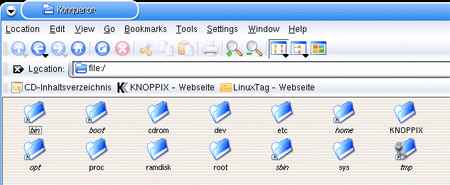Probably the single most confusing thing for new Linux users is the file
system. By this we mean the way files are stored, indexed and accessed on
the hard drive and other media. If you've gotten used to the Microsoft
Windows/DOS file systems (FAT32 and NTFS) you may be in for a bit of
disorientation here. There are no familiar drive letters now, no c:, d:,
etc. and no 'my computer' to provide a comforting overview of
everything. The Linux virtual file system (VFS) works quite a bit
differently; here's a quick overview:
In both Linux and Windows,
the idea of the ROOT directory is important, though less so in
Windows than in Linux. The ROOT is the base of your entire file system, the
origin of all directories, etc. Now in Windows, every drive and piece
of removable media has its own root directory, (c:, d:, e:, etc.)
with folders and directories branching off it.
In Linux, there
is one central ROOT directory and every device and file in the computer can be
located somewhere branching off it. This is the Virtual File System, in
which all devices and data (even drives using different file systems) are
assembled together into one large branching directory.
Think of it like this. In windows, each drive is its own tree, with its
branches being the files and folders contained within it. In Linux VFS,
there is only one, much larger tree and everything (including hardware, drivers
etc.) is contained somewhere within its branches.
When hard drives or removable media devices are added to a Windows system, a
new drive letter is created (d:,e: etc.), and that drive letter is used to
access and store data on that device.
When you add a new hard drive or removable media device
to a Linux system, a directory is created (or activated) through which the data
on that device can be accessed. This process is known as mounting the drive or
device. Essentially, you tell the operating system that all the files on the
device can be accessed by going to x directory. Like recent versions of Windows,
most modern Linux variants (including the version of Knoppix we are using now)
will perform this mounting operation automatically.
Now let's take a look at the directory structure of Linux and some of the
more important built-in directories. Click the Konqueror browser program
link on the taskbar ( a blue planet with metal spikes coming out of it)
In the address bar, type '/'

This brings you to the root of the Linux file system. The various
directories pictured make up the entirety of the operating system and user
files, including hardware drivers.

